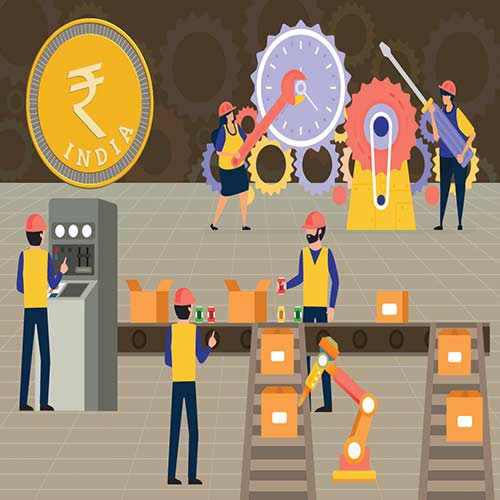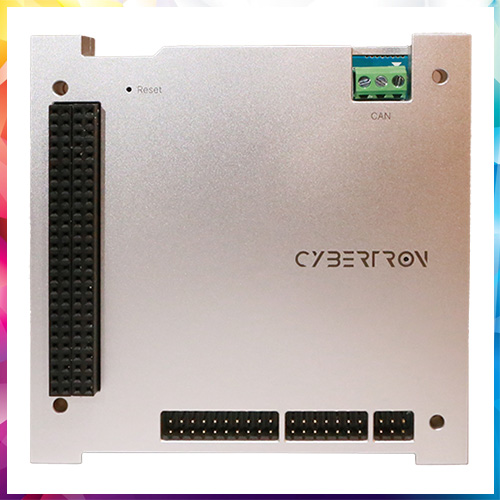
The PLI scheme is setting the stage ready for existing domestic manufacturing players to access the benefits and begin ground for the kind of production that has never been done in India. It will offer these players the privilege of not only expanding their units domestically but also compete in the global market in the long run -
The pandemic taught us of how dependence on one country by the entire world for components such as semiconductors, panels, key raw materials for the automobile and electronics industry can have an adverse effect on production. A country can improve its economic growth only when it promotes domestic production and becomes self-reliant.
The Production Linked Incentive (PLI) scheme is in line with the Make-In-India initiative along with PM Modi’s principle of ‘atma nirbharta’. It will strengthen the foundation of India’s path towards self-reliance.
 Apeksha Kaushik
Apeksha Kaushik
Principal Analyst - Gartner
"The PLI Scheme will provide low-cost indigenous products along with the Make in India initiative to build the infrastructure with the equipment and raw materials. Consequently, the cost associated with other projects will also come down. The PLI scheme based on incremental output is more effective and helps reduce the government expenditure and keep sustained investments."
 Rajesh Uttamchandani
Rajesh Uttamchandani
Director - Syska Group
"We are grateful for the government's support as it showcases our strength and capability in making India a global LED lighting manufacturing hub. As a leader in the LED lighting segment, we remain at the forefront to drive the Atmanirbhar Bharat initiative and strive to create economies of scale."
The scheme has been a game-changer in attracting industries from certain geographic locations to countries like India, where they can participate in both the domestic and export markets. While it invites foreign companies to set up their units in India, the scheme also encourages domestic enterprises to expand their production units. The flourishing of local manufacturing will enable India to be able to compete in global markets in the long run. By increasing manufacturing in various sectors, India can also reduce the unemployment ratio and also create skilled manpower.
“It has been a difficult time for many Indian manufacturers due to the pandemic,” cites Rajesh Uttamchandani, Director - Syska Group. “But with the backing of our Hon’ble Prime Minister Narendra Modi Ji and the various initiatives announced by his government, companies like Syska have been provided opportunities to achieve the production targets that we had set out. This initiative by Modi Ji has been presenting immense opportunities for our business as it will not only increase manufacturing capabilities for LED lighting products but also is supporting in raising the quality and system of production.”
Syska Group is one of the companies chosen as beneficiaries under the Production Linked Incentive (PLI) initiative.
Apeksha Kaushik, Principal Analyst with Gartner feels that India despite dominating the services sector, still needs to contribute more to the global supply chain and according to her PLI scheme can help India build an export base. “The scheme aims to develop local industries, besides facilitating innovation and research, development and up-gradation of technology of Indian firms,” she opines.
“The PLI Scheme thus provide for enough support to industries at their initial stage which are relatively new industries but growing fast at present. Further, these are expected to become important in the future and help sectors like Solar energy industries, Food Processing Industries, etc,” she further adds.
 Dr. Ajai Chowdhry
Dr. Ajai Chowdhry
Founder - EPIC Foundation
"Though the PLI scheme itself is very competitive, there are certain products where we need to relook at the real problem. For example - In the IT Hardware area, the incentives given are too low. Also, just like in Vietnam, there should be an added incentive for designing in India."
“This scheme can potentially change the world’s landscape when it comes to electronics and raw materials manufacturing by adding India to the list of manufacturing powerhouses,” says Avneet Singh Marwah CEO of SPPL, an exclusive brand licensee of Blaupunkt TV. “This scheme also makes it possible for other value-added advantages other than price reduction and modulation, such as enhanced quality, shorter lead times and more backward integration for all.”
Avneet further adds, “Even with India’s current manufacturing capabilities, our country enjoys a leading name as a manufacturer and with the PLI, it is only set to get better. We saw much price variation and instability with our dependence for raw materials on other countries. These basic challenges will be met with an in-house ecosystem in India, which will also ensure better backward integration for companies like ours too; this kind of system adds at least a 70% to 80% value addition.”
 Avneet Singh Marwah
Avneet Singh Marwah
CEO of SPPL, an exclusive brand licensee of Blaupunkt TV
"During the pandemic we realised how dependence on one country by the entire world for components such as semiconductors, panels- key raw materials for the automobile and electronics industry had made production come to a standstill. The PLI scheme is completely in line with the Make-In-India initiative along with our new found principle of ‘atma nirbharta’."
With the chip shortage continuing to grip the world, the Govt. has come out with a separate scheme with incentives totalling US$ 10B or 76,000 Cr for manufacturing semiconductors. This covers Fabs for semiconductors and Display as well DLI for design in India products.
“Semiconductor manufacturing will take some time but we at IESA are very confident that these schemes will attract many global and some local companies,” says Krishna Moorthy, CEO & President – IESA. “Besides incentives, the local supply chain echo system for semiconductor manufacturing is another important aspect and IESA has come out with a semiconductor supply chain report about developing this ecosystem.”
However, Dr. Ajai Chowdhry, Founder -EPIC Foundation is of the opinion that it is important to add more value to the whole concept and i.e. depth in manufacturing. “This means that we actually design in India by using the available components and then manufacture within the country. This is what has been the biggest challenge in the industry so far.”
 Krishna Moorthy
Krishna Moorthy
CEO & President - IESA
"Launching a US$ 10B fund for semiconductor manufacturing in India is the first good step already taken. Besides incentives, the local supply chain echo system for semiconductor manufacturing is another important aspect and IESA has come out with a semiconductor supply chain report about developing this ecosystem."
In order to make the whole process of application as seamless as possible and in sync with the government’s mission of digitising India, there is a single window clearance system. Companies are expected to properly file and submit their papers online and once the documentation is verified to be correct, the PLI scheme is set to go through for the applicant. In terms of availing the benefits of the scheme, the benefits of the scheme will come in from the following financial year only.
Current status of PLI
The government has recently informed in the Parliament that it is expecting an investment of Rs 34,090 crore under the PLI scheme for large-scale electronics manufacturing, mainly mobile phones and electronic components, by 2025. The government has approved proposals of 20 companies under the Scheme for Promotion of Manufacturing of Electronic Components and Semiconductors (SPECS), including that of Tata Electronics, till January 27, 2021.
Minister of state for electronics and IT Rajeev Chandrasekhar said in a written reply to the Rajya Sabha that around Rs 20,000 crore is expected to come from electronic components and semiconductor companies and Rs 14,090 crore from 32 proposals approved under the production linked incentive (PLI) scheme for large scale electronics manufacturing.
Leading contract manufacturers of Apple -- Foxconn, Pegatron and Wistron, South Korean electronics major Samsung, Indian companies Lava, Jio's Neolync, Optiemus Electronics etc have all participated in PLI for large scale electronics manufacturing.
Meity has approved 14 proposals under PLI for IT hardware which includes Dell, Foxconn subsidiary Rising Stars, Flextronics, Dixon Technologies, Panache Digilife, Netweb Technologies, Smile Electronics etc.

What is the PLI scheme?
The PLI scheme was conceived and launched in March 2020 to scale up domestic manufacturing capability to upto 30 lakh crore, substitute higher imports while also creating 60 lakh new jobs.
The scheme initially targeted three industries - Mobile and allied Component Manufacturing; Electrical Component Manufacturing and Medical Devices.
Later 14 key sectors were brought under the scheme with an outlay of Rs 1.97 lakh crore including automobile and auto components, electronics and IT hardware, telecom, pharmaceuticals, solar modules, metals and mining, textiles and apparel, white goods, drones, and advanced chemistry cell batteries.
An additional allocation of Rs 19,500 crore was made towards PLI for solar PV modules in Budget 2022-23.
The PLI scheme offers cash incentives to businesses for enhancing their domestic production while also focusing on cutting import costs and boosting the cost competitiveness of local products. The amount of incentive will vary from sector to sector.
The scheme was slated to begin in 2020-21 and continue for five years till 2025-26.
The identified beneficiaries are required to commit to a certain minimum investment in India.
The Challenges
This scheme is largely helping the IT sector, as is evident in multinationals and global companies showing interest in manufacturing in India. Keeping the service industry also in focus, development of both manufacturing and service industries can lead to being holistically competitive in the global market.
However, there are still a lot of areas to work upon. Sectors such as medical devices, textiles as well as automobile and automobile component manufacturing seek more participants.
Gartner’s Apeksha also states that there are no common set of parameters to understand the value addition by companies that have received or are likely to receive incentives under the PLI scheme. “Different ministries monitor the value addition of their respective PLI schemes, which makes difficult to compare two different schemes. Also, there are various deliverables such as the number of jobs created, the rise in exports and quality improvement and there is no centralised database to gauge all these,” she says.
The NITI Aayog also has plans to rope in an external agency to design and prepare the database in the coming days that will capture value addition, actual exports against commitments made, and job creation. A dashboard to flag hurdles at the state level will also be created.
Syska’s Rajesh points out that there is a massive global opportunity for the country’s manufacturing industry. It is important for it to think globally and innovate constantly not just for Indian businesses but for global markets as well. “It is also important to improve production facilities and increase efficiency which can significantly reduce the number of minerals needed to produce each MW of renewable energy equipment, allowing the government to make a strategic decision about which technology and manufacturing step to support,” he observes.
Dr Ajai Chowdhry points out that the scheme was introduced in the middle of the year and had a target of a full year. “Due to this a lot of organizations in the industry could not meet the target. I suggest, in the future, it will be good to give a full year run so that its targets are more realistic and achievable for everyone in the industry,” he recommends.
He further adds, “Though the PLI scheme itself is very competitive, there are certain products where we need to relook at the real problem. For example - In the IT Hardware area, the incentives given are too low. Also, I would like to add that just like in Vietnam, there should be an added incentive for designing in India.”
And so…
Government initiatives such as the PLI scheme will undoubtedly support home-grown businesses in expanding its manufacturing capabilities, boosting exports and bringing large-scale manufacturing to India. This is an incredible opportunity for the manufacturing economy to become self-sufficient and produce high-quality, globally competitive goods.
What has been disrupting the electronics industry for a long time is the lack of backward integration as key components like semiconductors and raw materials were not being produced in India which affected pricing. “A stable tax structure is also required, now, to set things in motion and these are exactly the aspects that have allowed other countries to take the centre stage- domestically and across the globe too,” sums up Avneet.
See What’s Next in Tech With the Fast Forward Newsletter
Tweets From @varindiamag
Nothing to see here - yet
When they Tweet, their Tweets will show up here.



























